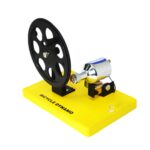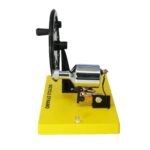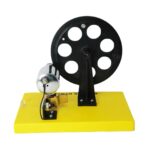- Pick up from the Samtech Store in Ambala
To pick up today
Free
- Courier delivery
Our courier will deliver to the specified address
4-5 Days
200+






₹1,000 Original price was: ₹1,000.₹675Current price is: ₹675. (Exc. GST)
To pick up today
Free
Our courier will deliver to the specified address
4-5 Days
200+
A classroom bicycle wheel dynamo setup typically uses a small cycle generator mounted on a base with output terminals for lights or meters. When the wheel or roller is spun (by hand or pedaling), the internal permanent magnet turns inside a fixed coil of wire, generating electricity.
Educational kits often include a lamp holder so students can see a bulb light up as the wheel turns. As rotation speed increases, the lamp grows brighter and any voltmeter/oscilloscope shows a larger induced voltage – directly illustrating Faraday’s law of electromagnetic induction. In effect the dynamo converts mechanical (kinetic) energy into electrical energy.
A bicycle dynamo typically contains a permanent magnet and a coil. In a bottle (sidewall) dynamo, the roller on the device presses against the spinning tire, causing an internal magnet to spin inside a stationary coil of wire. In a hub dynamo, the wheel’s axle houses magnets and stationary coils so that turning the wheel induces voltage without any external roller. In either case, electromagnetic induction produces a voltage in the coil: the faster it spins or the stronger the magnet, the higher the voltage (by Faraday’s law).

Traditional bicycle dynamos use a commutator so the output is DC, making it easy to light lamps. In practice, pedaling forces the magnet through the coil’s field, generating current – essentially like a small electric generator. An educational dynamo kit (like the Eisco assembly pictured) often mounts the dynamo on a frame and includes terminals and a lamp holder so students can directly observe the conversion of mechanical work to electrical energy.
In a lesson, students can pedal a bike or spin the dynamo wheel and observe various effects. Typical outcomes and concepts illustrated include:
Bicycle dynamos come in two common styles: sidewall (bottle/roller) dynamos and hub dynamos. The image above shows a bicycle wheel with an integrated hub dynamo in its axle. In contrast, a bottle (roller) dynamo is a separate unit that clamps onto the bike frame and presses a small roller wheel against the tire. Both types illustrate the same physics but behave differently in demos. For instance:
The bicycle dynamo model ties directly into many real-world technologies. For example:
Sources: Educational physics resources note that bicycle dynamos convert kinetic to electric energy, and their induced voltage depends on rotation speed. Comparisons of dynamo types show hub units are more efficient and weatherproof. Standard textbooks and kits use bicycle generators to teach Faraday’s law, energy conservation, and circuit behavior via hands-on demonstration.
In stock
In stock
In stock
In stock
No account yet?
Create an Account
SAMTECH INSTRUMENTS
Typically replies within minutes
Any questions related to Bicycle Wheel Dynamo Model?
🟢 Online | Privacy policy
WhatsApp us

